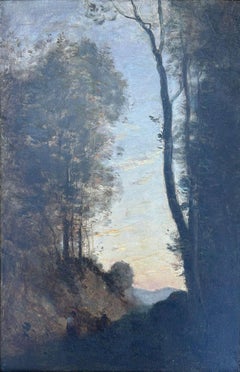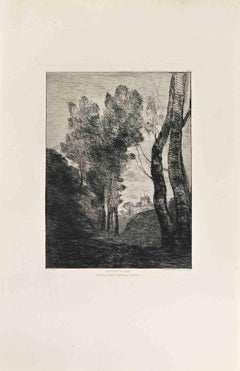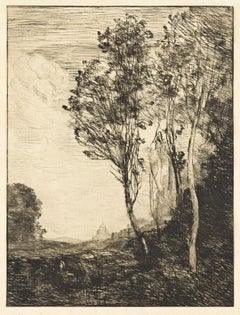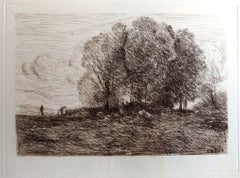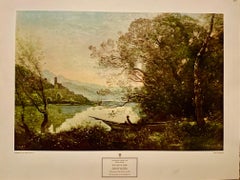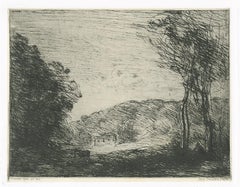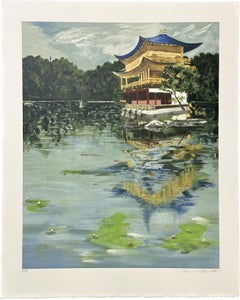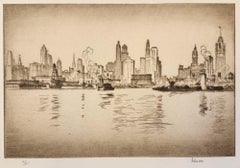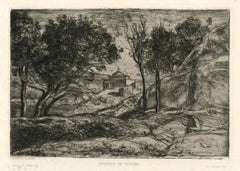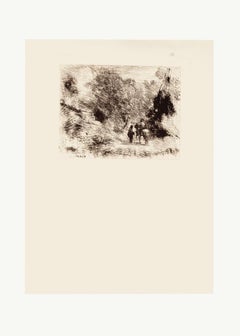Jean-Baptiste-Camille Corot Art
French, 1796-1875
Corot was a French landscape and portrait painter as well as a printmaker who is considered a great master of landscape painting in the 19th century. A pivotal figure in landscape painting, his vast output (over 3,000 paintings) simultaneously references the Neo-Classical tradition and anticipates the plein-air innovations of Impressionism. In the spring of 1829, Corot came to Barbizon to paint in the Forest of Fontainebleau, he had first painted in the forest at Chailly in 1822. He returned to Barbizon in the autumn of 1830 and in the summer of 1831, where he made drawings and oil studies, from which he made a painting intended for the Salon of 1830. The Barbizon school of painters were part of an art movement towards Realism in art, which arose in the context of the dominant Romantic Movement of the time. The Barbizon school was active roughly from 1830 through 1870.to
2
7
6
1
1
Overall Width
to
Overall Height
to
12
3
1
5
2
1
9
6
10
8
3
3
1
1
1
1
1
1
1
1
1
8
4
1
1
1
16
8,779
2,809
1,642
1,313
1
6
8
5
Artist: Jean-Baptiste-Camille Corot
"Soir dans une gorge Boisee" Jean-Baptiste-Camille Corot, Plein-Air Landscape
By Jean-Baptiste-Camille Corot
Located in New York, NY
Jean-Baptiste-Camille Corot
Soir dans une gorge Boisee, 1850-55
Signed lower right
Oil on board
13 1/2 x 9 inches
Provenance:
Dutilleux, Paul Tesse, etc.
Quincy Adams Shaw
Pauline S...
Category
1850s Impressionist Jean-Baptiste-Camille Corot Art
Materials
Oil, Panel
Environs de Rome - Etching by Camille Corot - 1860s
By Jean-Baptiste-Camille Corot
Located in Roma, IT
Environs de Rome is a black and White etching realized by Camille Corot in the 1860s.
Titled in the lower.
Image size: 31 x 22.
Very good impression with wide margins and a very ...
Category
1860s Contemporary Jean-Baptiste-Camille Corot Art
Materials
Etching
Souvenir d'Italie
By Jean-Baptiste-Camille Corot
Located in Greenwich, CT
Etching "Souvenir d'Italie” by Jean Baptiste Camille
printed on laid paper (partial watermark Annonay).
rich impression
size : sight 11.5 x 9 in. , matted 17 x 14 in.
A remarkab...
Category
Late 19th Century Romantic Jean-Baptiste-Camille Corot Art
Materials
Etching
Landscape #4 - Etching by Camille Corot - 1850s
By Jean-Baptiste-Camille Corot
Located in Roma, IT
Landscape #4 is a beautiful original etching realized by Camille Corot in the middle of XIX Century.
Image Dimensions: 18.5 x 25.5 cm
Very good conditions.
Includes passepartout....
Category
Mid-20th Century Modern Jean-Baptiste-Camille Corot Art
Materials
Etching
"The Lake of Terni" by Jean Baptiste Camille Corot; lithograph
By Jean-Baptiste-Camille Corot
Located in Chesterfield, MI
Jean Baptiste Camille Corot was a French landscape and portrait painter as well as a printmaker in etching. His prolific works simultaneously referenced the Neo-Classical tradition a...
Category
1860s Impressionist Jean-Baptiste-Camille Corot Art
Materials
Lithograph
Campagne boisée (Wooded countryside)
By Jean-Baptiste-Camille Corot
Located in Middletown, NY
1866
Etching on cream wove paper. 5 1/2 x 4 3/8 inches (138 x 110 mm), full margins. Third state (of 4). Light scattered age tone, and time stain. Scattered extremely light areas of ...
Category
Mid-19th Century Barbizon School Jean-Baptiste-Camille Corot Art
Materials
Etching
PAYSAGE D’ ITALIE
By Jean-Baptiste-Camille Corot
Located in Santa Monica, CA
JEAN-BAPTISTE CAMILLE COROT (1876 - 1875)
PAYSAGE D’ ITALIE 1866 (Melot 7 iii/iii)
Etching, plate 6 ¼ x 9 inches, Third state after the removal of the text but before the random scr...
Category
1860s Romantic Jean-Baptiste-Camille Corot Art
Materials
Etching
Souvenir d'Italie - Etching by Camille Corot - 1860s
By Jean-Baptiste-Camille Corot
Located in Roma, IT
Souvenir d'Italie is a black and White etching realized by Camille Corot in the 1860s.
Titled in the lower
Image Size: 32x23
Very good impression.
Realized for the "Société des ...
Category
1860s Modern Jean-Baptiste-Camille Corot Art
Materials
Etching
Paysage d'Italie - Etching by Camille Corot - 1870s
By Jean-Baptiste-Camille Corot
Located in Roma, IT
Paysage d'Italie is an artwork realized by Corot in the 1870s.
Etching.
Good conditions.
Realized for the "Société des Aquafortistes. Born on the initiative of the publisher Alfre...
Category
1870s Modern Jean-Baptiste-Camille Corot Art
Materials
Etching
Italian Landscape - Etching by Camille Corot - 19th Century
By Jean-Baptiste-Camille Corot
Located in Roma, IT
Etching realized by Camille Corot in 19th Century.
Prov. Collection Pecci-Blunt.
Very good condition.
Category
1860s Modern Jean-Baptiste-Camille Corot Art
Materials
Etching
Circa 1930 "Le Beffroi de Douai" to promote travel via the Chemin de fer du Nord
By Jean-Baptiste-Camille Corot
Located in PARIS, FR
In the 1930s, Corot, a notable artist of the era, crafted a captivating poster for "Le Beffroi de Douai" to promote travel via the Chemin de fer du Nord. This poster beautifully enca...
Category
1930s Jean-Baptiste-Camille Corot Art
Materials
Lithograph, Paper
Souvenir d’Eza
By Jean-Baptiste-Camille Corot
Located in Roma, IT
Cliché-verre.
Magnificent proof of ancient edition, numbered in red pencil on verso, and whose subject wasn’t included in the later reprints by Bouasse-Lebel and Le Garrec. Signed on...
Category
1870s Modern Jean-Baptiste-Camille Corot Art
Materials
Plate Glass
Le Clocher de St. Nicolas
By Jean-Baptiste-Camille Corot
Located in New York, NY
A very good impression of this scarce lithograph on wove paper. , Printed by Lemercier & Cie, Paris and published by Alfred Robaud. From "Douze Croquis et Dessins Originaux."
Catalo...
Category
1870s Realist Jean-Baptiste-Camille Corot Art
Materials
Lithograph
SOUVENIR D'OSTIE
By Jean-Baptiste-Camille Corot
Located in Portland, ME
Corot, Jean-Baptiste-Camille. SOUVENIR D'OSTIE. Delteil 57, Melot 57. Cliche Verre, 1855. Second State of two, with the signature of Corot in reverse, low...
Category
1850s Jean-Baptiste-Camille Corot Art
Materials
Black and White
"The Bridge of Narni" by Camille Corot. Limited Edition Lithograph: TP 666
By Jean-Baptiste-Camille Corot
Located in Chesterfield, MI
Limited Edition Print of "The Bridge of Narni" by Camille Corot
Published by The Twin Editions, New York Graphic Society, 1959.
Print measures 19 in x 26.2 in. Printed in Switzerland...
Category
20th Century Jean-Baptiste-Camille Corot Art
Materials
Lithograph
Related Items
San Francisco Golden Pavilion Signed Limited Edition Lithograph
By Tony Bennett
Located in Rochester Hills, MI
Tony Bennett
Title: San Francisco Golden Pavilion
Lithograph
Signed and Marked PP 2/10 ( Printers Proof )
Paper Size: 30" x 24" inches
Image Size : 25" x 20" inches
Published By : Atelier E. Ettinger Gallery
Anthony Dominick Benedetto, known professionally as Tony Bennett, is an American singer of traditional pop standards, big band, show tunes, and jazz. He is also a painter, having created works under his birth name that are on permanent public display in several institutions.
Whether he is performing as Tony Bennett or painting as Anthony Benedetto...
Category
1990s American Impressionist Jean-Baptiste-Camille Corot Art
Materials
Lithograph
$1,440 Sale Price
42% Off
H 28.5 in W 24 in D 1 in
Chicago Skyline
By Paul Schumann
Located in Middletown, NY
A beautiful turn-of-the-century lake view of Chicago by an American artist known for his Texas landscapes.
Etching with drypoint on watermarked Umbria laid paper with deckle edges, 7 1/4 x 10 7/8 inches (182 x 275 mm), full margins. Signed and numbered 4/25 in pencil, lower margin. In good condition with adhesive residue at the sheet edges on the verso, does not show through to the recto. A lovely Lake Michigan landscape...
Category
Early 20th Century American Modern Jean-Baptiste-Camille Corot Art
Materials
Handmade Paper, Etching, Drypoint
"Moonlight Romance" (2013) By Susie Hyer, Original Oil on Linen Panel
Located in Denver, CO
"Moonlight Romance" (2012) By Susie Hyer is an original handmade oil painting on stretched linen that depicts a landscape in dim moonlight. This painting measures 26 x 22 inches fram...
Category
2010s Impressionist Jean-Baptiste-Camille Corot Art
Materials
Linen, Oil, Panel
Ulysses Deriding Polyphemus: A Framed 19th C. Engraving After J. M. W. Turner
By J.M.W. Turner
Located in Alamo, CA
This beautiful 19th century framed hand-colored engraving/etching entitled "Ullyses Deriding Polyphemus" by Edward Goodall is based on an original 1829 painting by the renowned Briti...
Category
Mid-19th Century Romantic Jean-Baptiste-Camille Corot Art
Materials
Engraving, Etching
$675
H 13.88 in W 17.25 in D 1.5 in
"Evening View to the South West" , Oil Painting
By David Grossmann
Located in Denver, CO
David Grossman's (US based) "Evening View to the South West" is an original, handmade oil painting that depicts a wide open plain of the West with fields of...
Category
2010s American Impressionist Jean-Baptiste-Camille Corot Art
Materials
Linen, Oil, Panel
Romantic Landscape of Scandinavian Enchanted Forest, Large Lake Print Cyanotype
By Kind of Cyan
Located in Barcelona, ES
This is an exclusive handprinted limited edition cyanotype.
Lovely scene of a hidden pond in a Scandinavian forest.
Details:
+ Title: Scandinavian Enchanted Forest
+ Year: 2024
+ ...
Category
2010s Romantic Jean-Baptiste-Camille Corot Art
Materials
Photographic Film, Emulsion, Watercolor, Photographic Paper, C Print, Co...
$336 Sale Price
20% Off
H 28 in W 40 in
19th century color lithograph watercolor landscape figurative animal print
By Nathaniel Currier
Located in Milwaukee, WI
The present hand-colored lithograph presents the viewer with a hunting scene in a picturesque landscape. In the foreground, a man approaches two partridges as his two pointers prepare to flush them out. Beyond, a white fence draws our eyes to the homestead in the distance. Images like this one show how people in the United States were trying to identify themselves as a new nation in the North American landscape - as separate from their European counterparts but with similar similar and specific wildlife and magesties of nature. It also identifies hunting in this landscape as an American pastime.
9.25 x 12.5 inches, artwork
18.38 x 22 inches, frame
Entitled bottom center "Partridge Shooting...
Category
Mid-19th Century Romantic Jean-Baptiste-Camille Corot Art
Materials
Watercolor, Lithograph
19th century color lithograph figures cemetery willow tree memorial headstone
By Nathaniel Currier
Located in Milwaukee, WI
The present hand-colored lithograph was produced as part of the funeral and mourning culture in the United States during the 19th century. Images like this were popular as ways of remembering loved ones, an alternative to portraiture of the deceased. This lithograph shows a man, woman and child in morning clothes next to an urn-topped stone monument. Behind are additional putto-topped headstones beneath weeping willows, with a steepled church beyond. The monument contains a space where a family could inscribe the name and death dates of a deceased loved one. In this case, it has been inscribed to a young Civil War soldier:
William W. Peabody
Died at Fairfax Seminary, VA
December 18th, 1864
Aged 18 years
The young Mr. Peabody probably died in service for the Union during the American Civil War. Farifax Seminary was a Union hospital and military headquarters in Alexandria, Virginia. The hospital served nearly two thousand soldiers during the war time. Five hundred were also buried on the Seminary's grounds.
13.75 x 9.5 inches, artwork
23 x 19 inches, frame
Published before 1864
Inscribed bottom center "Lith. & Pub. by N. Currier. 2 Spruce St. N.Y."
Framed to conservation standards using 100 percent rag matting and TruVue Conservation Clear glass, housed in a gold gilded moulding.
Nathaniel Currier was a tall introspective man with a melancholy nature. He could captivate people with his piercing stare or charm them with his sparkling blue eyes. Nathaniel was born in Roxbury, Massachusetts on March 27th, 1813, the second of four children. His parents, Nathaniel and Hannah Currier, were distant cousins who lived a humble yet spartan life. When Nathaniel was eight years old, tragedy struck. Nathaniel’s father unexpectedly passed away leaving Nathaniel and his eleven-year-old brother Lorenzo to provide for the family. In addition to their mother, Nathaniel and Lorenzo had to care for six-year-old sister Elizabeth and two-year-old brother Charles. Nathaniel worked a series of odd jobs to support the family, and at fifteen, he started what would become a life-long career when he apprenticed in the Boston lithography shop of William and John Pendleton.
A Bavarian gentleman named Alois Senefelder invented lithography just 30 years prior to young Nat Currier’s apprenticeship. While under the employ of the brothers Pendleton, Nat was taught the art of lithography by the firm’s chief printer, a French national named Dubois, who brought the lithography trade to America.
Lithography involves grinding a piece of limestone flat and smooth then drawing in mirror image on the stone with a special grease pencil. After the image is completed, the stone is etched with a solution of aqua fortis leaving the greased areas in slight relief. Water is then used to wet the stone and greased-ink is rolled onto the raised areas. Since grease and water do not mix, the greased-ink is repelled by the moisture on the stone and clings to the original grease pencil lines. The stone is then placed in a press and used as a printing block to impart black on white images to paper.
In 1833, now twenty-years old and an accomplished lithographer, Nat Currier left Boston and moved to Philadelphia to do contract work for M.E.D. Brown, a noted engraver and printer. With the promise of good money, Currier hired on to help Brown prepare lithographic stones of scientific images for the American Journal of Sciences and Arts. When Nat completed the contract work in 1834, he traveled to New York City to work once again for his mentor John Pendleton, who was now operating his own shop located at 137 Broadway. Soon after the reunion, Pendleton expressed an interest in returning to Boston and offered to sell his print shop to Currier. Young Nat did not have the financial resources to buy the shop, but being the resourceful type he found another local printer by the name of Stodart. Together they bought Pendleton’s business.
The firm ‘Currier & Stodart’ specialized in "job" printing. They produced many different types of printed items, most notably music manuscripts for local publishers. By 1835, Stodart was frustrated that the business was not making enough money and he ended the partnership, taking his investment with him. With little more than some lithographic stones, and a talent for his trade, twenty-two year old Nat Currier set up shop in a temporary office at 1 Wall Street in New York City. He named his new enterprise ‘N. Currier, Lithographer’
Nathaniel continued as a job printer and duplicated everything from music sheets to architectural plans. He experimented with portraits, disaster scenes and memorial prints, and any thing that he could sell to the public from tables in front of his shop. During 1835 he produced a disaster print Ruins of the Planter's Hotel, New Orleans, which fell at two O’clock on the Morning of the 15th of May 1835, burying 50 persons, 40 of whom Escaped with their Lives. The public had a thirst for newsworthy events, and newspapers of the day did not include pictures. By producing this print, Nat gave the public a new way to “see” the news. The print sold reasonably well, an important fact that was not lost on Currier.
Nat met and married Eliza Farnsworth in 1840. He also produced a print that same year titled Awful Conflagration of the Steamboat Lexington in Long Island Sound on Monday Evening, January 18, 1840, by which melancholy occurrence over One Hundred Persons Perished. This print sold out very quickly, and Currier was approached by an enterprising publication who contracted him to print a single sheet addition of their paper, the New York Sun. This single page paper is presumed to be the first illustrated newspaper ever published.
The success of the Lexington print launched his career nationally and put him in a position to finally lift his family up. In 1841, Nat and Eliza had their first child, a son they named Edward West Currier. That same year Nat hired his twenty-one year old brother Charles and taught him the lithography trade, he also hired his artistically inclined brother Lorenzo to travel out west and make sketches of the new frontier as material for future prints. Charles worked for the firm on and off over the years, and invented a new type of lithographic crayon which he patented and named the Crayola. Lorenzo continued selling sketches to Nat for the next few years.
In 1843, Nat and Eliza had a daughter, Eliza West Currier, but tragedy struck in early 1847 when their young daughter died from a prolonged illness. Nat and Eliza were grief stricken, and Eliza, driven by despair, gave up on life and passed away just four months after her daughter’s death.
The subject of Nat Currier’s artwork changed following the death of his wife and daughter, and he produced many memorial prints and sentimental prints during the late 1840s. The memorial prints generally depicted grief stricken families posed by gravestones (the stones were left blank so the purchasers could fill in the names of the dearly departed). The sentimental prints usually depicted idealized portraits of women and children, titled with popular Christian names of the day.
Late in 1847, Nat Currier married Lura Ormsbee, a friend of the family. Lura was a self-sufficient woman, and she immediately set out to help Nat raise six-year-old Edward and get their house in order. In 1849, Lura delivered a son, Walter Black Currier, but fate dealt them a blow when young Walter died one year later. While Nat and Lura were grieving the loss of their new son, word came from San Francisco that Nat’s brother Lorenzo had also passed away from a brief illness. Nat sank deeper into his natural quiet melancholy. Friends stopped by to console the couple, and Lura began to set an extra place at their table for these unexpected guests. She continued this tradition throughout their lives.
In 1852, Charles introduced a friend, James Merritt Ives, to Nat and suggested he hire him as a bookkeeper. Jim Ives was a native New Yorker born in 1824 and raised on the grounds of Bellevue Hospital where his father was employed as superintendent. Jim was a self-trained artist and professional bookkeeper. He was also a plump and jovial man, presenting the exact opposite image of his new boss.
Jim Ives met Charles Currier through Caroline Clark, the object of Jim’s affection. Caroline’s sister Elizabeth was married to Charles, and Caroline was a close friend of the Currier family. Jim eventually proposed marriage to Caroline and solicited an introduction to Nat Currier, through Charles, in hopes of securing a more stable income to support his future wife.
Ives quickly set out to improve and modernize his new employer’s bookkeeping methods. He reorganized the firm’s sizable inventory, and used his artistic skills to streamline the firm’s production methods. By 1857, Nathaniel had become so dependent on Jims’ skills and initiative that he offered him a full partnership in the firm and appointed him general manager. The two men chose the name ‘Currier & Ives’ for the new partnership, and became close friends.
Currier & Ives produced their prints in a building at 33 Spruce Street where they occupied the third, fourth and fifth floors. The third floor was devoted to the hand operated printing presses that were built by Nat's cousin, Cyrus Currier, at his shop Cyrus Currier & Sons in Newark, NJ. The fourth floor found the artists, lithographers and the stone grinders at work. The fifth floor housed the coloring department, and was one of the earliest production lines in the country. The colorists were generally immigrant girls, mostly German, who came to America with some formal artistic training. Each colorist was responsible for adding a single color to a print. As a colorist finished applying their color, the print was passed down the line to the next colorist to add their color. The colorists worked from a master print displayed above their table, which showed where the proper colors were to be placed. At the end of the table was a touch up artist who checked the prints for quality, touching-in areas that may have been missed as it passed down the line. During the Civil War, demand for prints became so great that coloring stencils were developed to speed up production.
Although most Currier & Ives prints were colored in house, some were sent out to contract artists. The rate Currier & Ives paid these artists for coloring work was one dollar per one hundred small folios (a penny a print) and one dollar per one dozen large folios. Currier & Ives also offered uncolored prints to dealers, with instructions (included on the price list) on how to 'prepare the prints for coloring.' In addition, schools could order uncolored prints from the firm’s catalogue to use in their painting classes.
Nathaniel Currier and James Merritt Ives attracted a wide circle of friends during their years in business. Some of their more famous acquaintances included Horace Greeley, Phineas T. Barnum, and the outspoken abolitionists Rev. Henry Ward, and John Greenleaf Whittier (the latter being a cousin of Mr. Currier).
Nat Currier and Jim Ives described their business as "Publishers of Cheap and Popular Pictures" and produced many categories of prints. These included Disaster Scenes, Sentimental Images, Sports, Humor, Hunting Scenes, Politics, Religion, City and Rural Scenes, Trains, Ships, Fire Fighters, Famous Race Horses, Historical Portraits, and just about any other topic that satisfied the general public's taste. In all, the firm produced in excess of 7500 different titles, totaling over one million prints produced from 1835 to 1907.
Nat Currier retired in 1880, and signed over his share of the firm to his son Edward. Nat died eight years later at his summer home 'Lion’s Gate' in Amesbury, Massachusetts. Jim Ives remained active in the firm until his death in 1895, when his share of the firm passed to his eldest son, Chauncey.
In 1902, faced will failing health from the ravages of Tuberculosis, Edward Currier sold his share of the firm to Chauncey Ives...
Category
Mid-19th Century Romantic Jean-Baptiste-Camille Corot Art
Materials
Watercolor, Lithograph
“Tending the Sheep”
By Myles Birket Foster
Located in Southampton, NY
Beautifully executed original hand colored lithograph using gouache and watercolor. Scene in Surrey, England. Signedxwith monogram in plate lower left, Myles Birket Foster. Published by M. H. Long. Condition is very good. In original 2 inch wide birdseye maple antique frame with thick museum mat with gold innner edge. Overall 22 by 26 inches.
Biography
Myles Birket Foster (4 February 1825 – 27 March 1899) was a popular English illustrator, watercolour artist and engraver in the Victorian period. His name is also to be found as Myles Birkett Foster.
Life and work
Foster was born in North Shields, England of a primarily Quaker family, but his family moved south to London in 1830, where his father founded M. B. Foster & sons — a successful beer-bottling company. He was schooled at Hitchin, Hertfordshire and on leaving initially went into his father's business. However, noticing his talent for art, his father secured an apprenticeship with the notable wood engraver, Ebenezer Landells, where he worked on illustrations for Punch magazine and the Illustrated London News.
On leaving Landells' employ, he continued to produce work for the Illustrated London News and the Illustrated London Almanack. He also found work as a book illustrator and, during the 1850s, trained himself to paint in watercolours. His illustrations of Longfellow’s Evangeline and books of poetry by other contemporaries were a great success, and he quickly became a successful artist in watercolours. Birket Foster became an Associate of the "Old" Watercolour Society (Later the Royal Watercolour Society) in 1860 and exhibited some 400 of his paintings at the Royal Academy over more than 2 decades.
Birket Foster travelled widely, painting the countryside around Scotland, the Rhine Valley, the Swiss lakes and in Italy, especially Venice. In 1863 he moved to Witley, near Godalming in Surrey where he had a house ("The Hill") built. Being friendly with Edward Burne-Jones and William Morris, he had the house decorated and furnished in contemporary style, with tiles and paintings by Burne-Jones and Morris' firm, Morris and Company. The same year he published a volume of "English Landscapes," with text by Tom Taylor...
Category
1880s Impressionist Jean-Baptiste-Camille Corot Art
Materials
Lithograph, Watercolor, Gouache
$1,120 Sale Price
20% Off
H 9.25 in W 14.75 in D 1 in
Ernest David Roth, Toledo, The Approach
By Ernest David Roth
Located in New York, NY
Working in the tradition of the Etching Revival, Ernest David Roth made this amazingly conceived and detailed study of the entrance to the Spanish ci...
Category
Early 20th Century American Modern Jean-Baptiste-Camille Corot Art
Materials
Etching
Original "Spain" original 1943 travel poster Delpy
Located in Spokane, WA
Original SPAIN; vintage European antique travel poster. Size: 24.5" 38.25". Year: 1943. Artist: Delpy. Archival linen-backed vintage lithograph, ready to frame. Print...
Category
1940s American Impressionist Jean-Baptiste-Camille Corot Art
Materials
Lithograph
$478 Sale Price
20% Off
H 38.25 in W 24.5 in D 0.05 in
Tugs on the Hudson
By Charles Frederick William Mielatz
Located in Middletown, NY
Drypoint etching with engraving printed in black ink on Japanese mulberry paper, 4 1/2 x 3 3/8 inches (113 x 84 mm), full margins. In superb condition. A beautiful New York City river...
Category
Early 20th Century American Modern Jean-Baptiste-Camille Corot Art
Materials
Handmade Paper, Drypoint, Etching
Previously Available Items
"Souvenir de Toscane" original etching
By Jean-Baptiste-Camille Corot
Located in Henderson, NV
Medium: original etching. Catalogue reference Delteil 1. This impression on cream laid paper was published by the Gazette des Beaux-Arts in 1903. Plate size: 4 7/8 x 7 inches (125 x ...
Category
Early 1900s Barbizon School Jean-Baptiste-Camille Corot Art
Materials
Etching
Landscape - Original Etching by Camille Corot - 19th Century
By Jean-Baptiste-Camille Corot
Located in Roma, IT
Landscape is an original print artwork realized by Camille Corot.
Plate signed.
In good condition.
Included a Passepartout: 49 x 34
Light, and brilli...
Category
19th Century Naturalistic Jean-Baptiste-Camille Corot Art
Materials
Etching
H 5.52 in W 7.29 in D 0.04 in
Landscape - Original Etching by Camille Corot - 19th Century
By Jean-Baptiste-Camille Corot
Located in Roma, IT
Landscape is an original print artwork realized by Camille Corot.
With the stamp of "Collezione Contessa Laetitia Pecci-Blunt" lower right on the rear.
In good condition except for diffused foxing and the trace of humidity just below the top margin.
Included a Passepartout: 49 x 34 cm. Image Dimensions: 16.5 x 23 cm
Light, and brilliant landscape with the poetical expression of trees, the work is characterized by a well-balanced lightning which created a strong feeling of the scene, with the movement of trees in the wind through intense black made shadows and light with a strong feeling of nature.
Jean-Baptiste Camille Corot...
Category
19th Century Modern Jean-Baptiste-Camille Corot Art
Materials
Etching
H 16.54 in W 12.21 in D 0.04 in
Landscape - Original Etching on Paper by Camille Corot - 19th Century
By Jean-Baptiste-Camille Corot
Located in Roma, IT
Landscape is an original etching artwork realized by Camille Corot.
With the stamp of "Collezione Contessa Laetitia Pecci-Blunt" lower right on the rear...
Category
19th Century Realist Jean-Baptiste-Camille Corot Art
Materials
Etching
H 6.7 in W 9.06 in D 0.04 in
Landscape #4 - Etching by Camille Corot - 1850s
By Jean-Baptiste-Camille Corot
Located in Roma, IT
Landscape #4 is a beautiful original etching realized by Camille Corot in the middle of XIX Century.
Image Dimensions: 18.5 x 25.5 cm
Very good condit...
Category
Mid-20th Century Modern Jean-Baptiste-Camille Corot Art
Materials
Etching
H 16.54 in W 12.21 in D 0.04 in
La Porte d'Arras - Etching by Camille Corot - 1870
By Jean-Baptiste-Camille Corot
Located in Roma, IT
La porte d'Arras is a beautiful original etching realized by Camille Corot in 1870.
Very good conditions. Signed on the lower right margin of the plate...
Category
1870s Jean-Baptiste-Camille Corot Art
Materials
Etching
H 6.7 in W 5.63 in D 0.04 in
Landscape - Original Etching By Camille Corot - Late 19th Century
By Jean-Baptiste-Camille Corot
Located in Roma, IT
Image dimensions: 10 x 15 cm.
Landscape is an original print artwork realized by Camille Corot. With the stamp of "Collezione Contessa Laetitia Pecci-Bl...
Category
Late 19th Century Modern Jean-Baptiste-Camille Corot Art
Materials
Etching
H 16.54 in W 12.21 in D 0.04 in
Landscape - Original Etching By Camille Corot - Late 19th Century
By Jean-Baptiste-Camille Corot
Located in Roma, IT
Landscape is an original etching, realized by Camille Corot (1796-1875). with the stamp" Collection Contessa Anna Laetitia Pecci-Bblunt" on the lower lef...
Category
Late 19th Century Modern Jean-Baptiste-Camille Corot Art
Materials
Etching
H 16.54 in W 12.01 in D 0.04 in
Le Gué aux Cinq Vaches (The Ford with Five Cows)
By Jean-Baptiste-Camille Corot
Located in New Orleans, LA
This ethereal landscape with its luminous atmosphere and light-drenched palette is a quintessential plein air masterpiece by the renowned French painter Jean-Baptiste-Camille Corot. Regarded by many as the first Impressionist, Corot's paintings served as the inspiration for an entire generation of artists. This example, entitled Le Gué aux Cinq Vaches (The Ford with Five Cows), offers a tranquil scene rendered in his mature style, composed at the apogee of his career after he abandoned the crisp brushwork and classical lines of his predecessors. Rather, the feathery brushstrokes and softened atmosphere of this charming tableau reveals the genius of this legendary artist and portends the revolutionary style of the Impressionists to come.
Corot’s work occupies a space between old and new, traditional and modern, in the realm of 19th-century art history. Though he never broke with the traditionalists and academics who remained loyal to the Salon, his works possessed a unique individuality that set his oeuvre apart from other landscape artists of his age. As Etienne Moreau-Nelaton once said, he was “ the last of the classical landscapists and the first of the Impressionists.” His brushstrokes, bold and solid yet feathery and light, transformed the neoclassical landscape and altered plein air painting forever.
Corot received a classical education in Rouen before embarking upon an apprenticeship in the family textile trade. The painting was his true passion and he soon devoted his entire life to perfecting his skill. Corot studied first with Achille Etna Michallon and Jean-Victor Bertin, both pupils of the leading historical landscape painter Pierre-Henri de Valenciennes. He visited the countryside of Rome and produced plein air studies, capturing the area’s natural beauty and classical antiquity. His fresh, starkly lit renditions reflect the debate of the day that sought to reconcile classically inspired idealizations with closely observed depictions of light and climate.
He debuted at the Paris Salon in 1827, and continued to display there his entire life. As a result, many of these paintings were purchased by the state for provincial museums and by important collectors such as Emperor Napoleon III. For his enduring contribution to the arts, Corot was made a Knight of the Legion of Honor in 1846 and an Officer in 1867. At the Munich International Exposition of 1869, he was made a Knight of the Order of St. Michael.
As seen in this extraordinary example, Corot’s work reveals a deep understanding of the French landscape. The dramatic distribution of light and shadow recalls the romantic compositions of Delacroix, while the overwhelming presence of nature pays homage to the influence of the great Barbizon artists. Quintessentially French, Corot’s oeuvre was profoundly influential both upon his contemporaries and later generations of artists. Today, Corot's paintings of idyllic landscapes are in high demand on the art market, with both museums and private collectors competing for his works.
This important work is featured on pp. 188-189 of L'Oeuvre de Corot: catalogue raisonné et illustré, Paris 1905, Vol. III, by A. Robaut, with a drawing by Robaut, no. 1756.
Circa 1865
Canvas: 9 3/4" high x 15 1/2" wide
Frame: 14" high x 19 1/2" wide
Provenance:
Georges Petit, Paris, 1880, inv. no.6.624 (label on the reverse)
Bernheim Jeune, Paris, inv. no.3522 (label on the reverse)
Private collection, France
Private collection, London
M.S. Rau Antiques...
Category
19th Century Academic Jean-Baptiste-Camille Corot Art
Materials
Canvas, Oil
Landscape #4 - Original Etching by Camille Corot - 1850
By Jean-Baptiste-Camille Corot
Located in Roma, IT
Landscape #4 is a beautiful original etching realized by Camille Corot in the middle of XIX Century. Very good conditions except for a halo on the lower...
Category
1850s Modern Jean-Baptiste-Camille Corot Art
Materials
Etching
H 16.54 in W 12.21 in D 0.04 in
Landscape #3
By Jean-Baptiste-Camille Corot
Located in Roma, IT
Landscape is a beautiful original etching realized by Camille Corot in the middle of XIX Century. Perfect conditions, platemark is present.
It represents a natural landscape with som...
Category
1850s Modern Jean-Baptiste-Camille Corot Art
Materials
Etching
Souvenir de Fampoux
By Jean-Baptiste-Camille Corot
Located in Roma, IT
Cliché-verre.
Fine proof of the ancient edition, in brown. Minor removals on the subject, which wasn’t included in the later reprints by Bouasse-Lebel and Le Garrec. Monogram on plat...
Category
1850s Modern Jean-Baptiste-Camille Corot Art
Materials
Plate Glass
Jean-baptiste-camille Corot art for sale on 1stDibs.
Find a wide variety of authentic Jean-Baptiste-Camille Corot art available for sale on 1stDibs. You can also browse by medium to find art by Jean-Baptiste-Camille Corot in etching, oil paint, paint and more. Much of the original work by this artist or collective was created during the 19th century and is mostly associated with the modern style. Not every interior allows for large Jean-Baptiste-Camille Corot art, so small editions measuring 4 inches across are available. Customers who are interested in this artist might also find the work of Félix Bracquemond, Maurice Utrillo, and Claude Hemeret. Jean-Baptiste-Camille Corot art prices can differ depending upon medium, time period and other attributes. On 1stDibs, the price for these items starts at $175 and tops out at $499,296, while the average work can sell for $850.
Artists Similar to Jean-Baptiste-Camille Corot
Questions About Jean-Baptiste-Camille Corot Art
- Was Corot a Realist?1 Answer1stDibs ExpertAugust 26, 2024Yes, Corot was a Realist. He is particularly well known for his realistic depictions of historical and mythological scenes set in rural landscapes, often depicted beneath hazy rather than idyllic blue skies. Some of his most famous works include Souvenir de Mortefontaine, Orpheus Leading Eurydice from the Underworld and Hagar in the Wilderness. Find a selection of Jean-Baptiste-Camille Corot art on 1stDibs.
